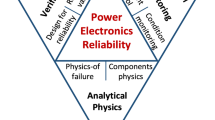Abstract
The conventional part failure analysis only takes into account the type, number, and connection status of the components, so failure rates according to the operating characteristics of the converter cannot be reflected. On the other hand, FTA uses a fault-tree showing cause, effect, and result of the fault, so it can predict the failure-rate considering the operational risk of converter. In this paper, the fault-tree is designed considering the operational characteristics of each of the boost converter and the interleaved boost converter, and the lifetime of both converters are predicted by using MIL-HDBK-217F. The validity of the proposed method is verified by comparing with the part failure analysis. Finally, we compare the weight and volume with MTBF according to the power capacity, and propose the selection guide of the boost converter or IBC in the viewpoint of failure-rate.










Similar content being viewed by others
References
Aghdam FH, Abapour M (2016) Reliability and cost analysis of multistage boost converters connected to PV panels. IEEE J Photovolt 6:981–989
Katore AV, Munshi AP (2018) Reliability evaluation of multi-level boost converter. Int Conf Smart Electr Drives Power Syst pp 317–323
Khosroshahi A, Abapour M, Sabahi M (2015) Reliability evaluation of conventional and interleaved DC–DC boost converters. IEEE Trans Power Electron 30:5821–5828
Khazraj H, Ashouri M, Faria da Silva F, Bak CL (2018) Investigation of DC–DC boost converter for reliability of operational planning. In: IEEE international conference on environment and electrical engineering, Palermo
Bryant AT, Mawby PA, Palmer PR, Santi E, Hudgins JL (2008) Exploration of power device reliability using compact device models and fast electrothermal simulation. IEEE Trans Ind Appl 44(3):894–903
Choudhary K, Sidharthan P (2015) Reliability prediction of electronic power conditioner (EPC) using MIL-HDBK-217 based parts count method. In: IEEE international conference on computer, communication and control, Indore
Giral R, Martinez-salamero L, Singer S (1999) Interleaved converters operation based on CMC. IEEE Trans Power Electron 14:643–652
Perreault DJ, Kassakian JG (1997) Distributed interleaving of paralleled power converters. IEEE Trans Circ Syst I 44:728–733
Lee PW, Lee YS, Cheng DKW, Liu XC (2000) Steady-state analysis of an interleaved boost converter with coupled inductors. IEEE Trans Ind Electron 47:787–795
Giral R, Martinez-salamero L, Leyva R, Maixe J (2000) Sliding-mode control of interleaved boost converters. IEEE Trans Circ Syst I 47:1330–1339
Veerachary M, Senjyu T, Uezato K (2001) Modeling and analysis of interleaved dual boost converter. In: Proceedings of ISIE conference, Pusan, pp 718–722
Mclyman CWT (2004) Transformer and inductor design handbook, 3rd edn. Routledge, New York
Wallmeier P (2002) Pre-optimization of linear and nonlinear inductors using area-product formulation. In: Proceedings of 37th industry applications conference (IAS), pp 2445–2450
Reliability prediction of electric equipment, Department of Defense, Washington DC, Tech. Rep. MIL-HDBK-217F, Dec. 1991
Mou H, Hu W, Sun Y, Zhao G (2013) A comparison and case studies of electronic product reliability prediction methods based on handbooks. In: IEEE international conference on quality, reliability, risk, maintenance, and safety engineering (QR2MSE), Chengdu, China, pp 112–115
Valentine N, Das D, Pecht M (2015) Failure mechanisms of insulated gate bipolar transistors (IGBTs). In: NREL photovoltaic reliability workshop, 2015
Lambilly H, Keser HO (1993) Failure analysis of power modules: a look at the packaging and reliability of large IGBT’s. IEEE Trans Components Hybrid Manuf Technol 16:412–417
Yang S, Bryant A, Mawby P, Xiang D, Ran L, Tavner P (2011) An industry-based survey of reliability in power electronic converters. IEEE Trans Ind Appl 47(3):1441–1451
Song Y, Wang B (2013) Survey on reliability of power electronics systems. IEEE Trans Power Electron 28:591–604
Acknowledgements
The research was supported by the research fund of Hanbat National University in 2017.
Author information
Authors and Affiliations
Corresponding author
Additional information
Publisher's Note
Springer Nature remains neutral with regard to jurisdictional claims in published maps and institutional affiliations.
Rights and permissions
About this article
Cite this article
Yeo, S.C., Kang, Fs. Fault-Tree Based Failure-Rate Analysis for Boost Converter and Interleaved Boost Converter. J. Electr. Eng. Technol. 14, 2375–2387 (2019). https://doi.org/10.1007/s42835-019-00284-w
Received:
Revised:
Accepted:
Published:
Issue Date:
DOI: https://doi.org/10.1007/s42835-019-00284-w




